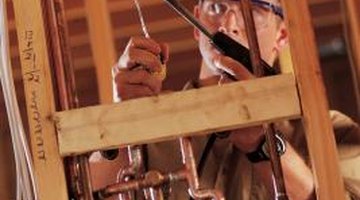Can I Use Compression Fittings to Install a Shower Fixture?
Compression fittings are threaded fittings that allow two pieces of pipe or tubing to be connected without the need for sweating the pipe, or soldering the joint. Compression fittings can greatly reduce the amount of work involved in many plumbing repairs, but they are not suitable for every application. Deciding whether to use a compression fitting depends on what part of your shower fixture you are working on.
Pros: Compression Fittings

Compression fittings can be easily installed on the end of a length of hose or pipe. They have "male" and "female" threaded ends that fit together without the need for soldering joints. This makes these fittings especially useful in tight spots where the use of a propane torch would be difficult or dangerous. Compression fittings also can be removed after installation; a soldered joint is permanent.
Cons: Compression Fittings
Compression fittings are not suitable where there will be considerable rotational movement. A compression fitting works well on the end of a garden hose but will come loose if you continually twist the hose. The same is true of other plumbing applications, and compression fittings should not be used where there will be rotational movement that could loosen the joint.
Behind the Wall Plumbing for Shower Fixture
When installing a shower fixture, compression fittings can be used for the plumbing inside the wall of your bathroom. This includes the hot and cold water feed lines and the main pipe that feeds into your fixture. Any portion of the shower fixture that will not be subject to movement can have a compression fitting installation.
Note of Warning
While compression fittings can be used for any low-pressure plumbing applications that are not subject to movement, you may want to consider the potential problems inherent in using them. If you are installing a shower stall or tile board that will make reaching the in-wall plumbing for repair especially difficult, you may want to use the soldering method. Compression fittings can work themselves loose over time, and a leak behind a shower stall can be a major problem. Consider how accessible your compression fittings will be for repair and tightening before settling on this option.
References
Writer Bio
Andrew Leahey has been a writer since 1999, covering topics as varied as technology how-to guides and the politics of genetically modified organisms to African food supplies. He is pursuing his J.D. while renovating an 1887 farmhouse located in the New Jersey Pine Barrens.
Photo Credits
- Comstock/Comstock/Getty Images
More Articles



